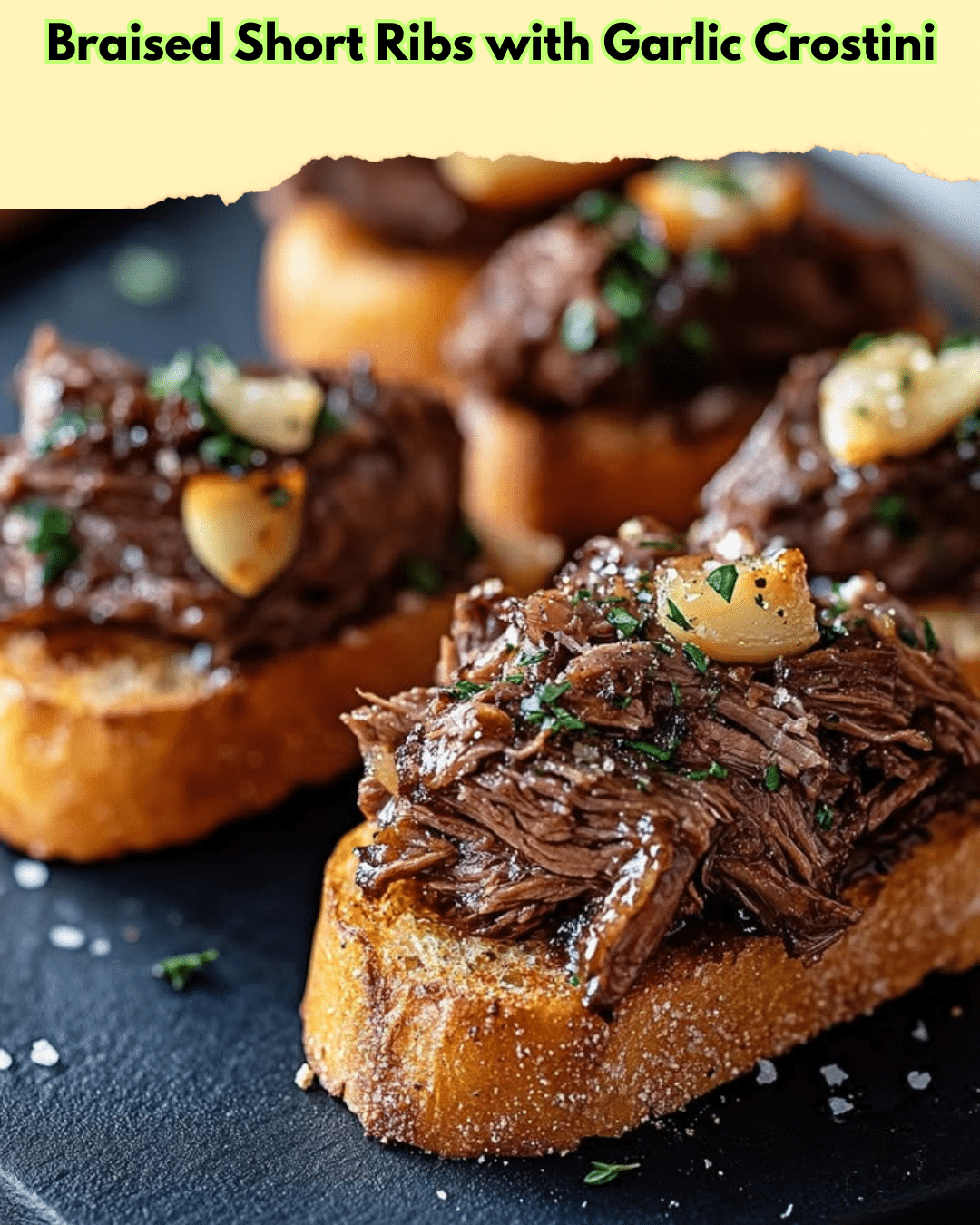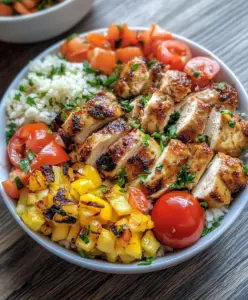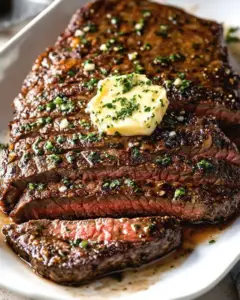Braised Short Ribs with Garlic Crostini: A Hearty and Flavorful Delight
Braising short ribs yield a dish that’s both rustic and sophisticated, perfect for impressing your dinner guests or savoring on a night in. The slow-cooked beef becomes incredibly tender, soaking up the rich flavors of the braising liquid, while the garlic crostini offers a delightful crunch. This recipe brings together the deeply savory taste of red wine and beef stock, with aromatic vegetables and fresh herbs infusing every bite. It is the perfect meal for those who appreciate a hearty, comfort food experience.
The braised short ribs with garlic crostini are all about indulgence and satisfaction. The luscious short ribs combine with the earthy sweetness of carrots and the robust taste of garlic to create a dish that feels both wholesome and luxurious. Every forkful is tender, with the meat practically falling off the bone, and the flavors coaxed to perfection during the long braising process.
The aroma of this dish fills the kitchen with an inviting scent, promising warmth and delight even before you begin eating. The rich fragrance of the garlic and herbs is complemented by the full-bodied red wine, making it a true feast for the senses. Those who relish the artistry of detailed cooking will find the preparation of braised short ribs with garlic crostini both rewarding and achievable.
Quick Recipe Highlights
- Flavor Profile: A blend of savory beef, aromatic garlic, and sweet carrots, all simmered in a rich red wine sauce.
- Texture: Tender, melt-in-your-mouth beef short ribs complemented by crispy garlic crostini.
- Aroma: Filled with the enticing scents of garlic, fresh herbs, and wine.
- Visual Appeal: A rustic, yet elegant presentation with vibrant carrots and lush herbs set against savory meat.
- Skill Level Needed: Perfect for those comfortable with slow-cooking methods and seeking to refine culinary skills.
- Special Equipment: A heavy-duty Dutch oven or deep skillet for braising, and a sharp knife for crostini preparation.
Recipe Overview
- Difficulty Level: This recipe is moderate and requires some familiarity with browning meat and slow-cooking techniques, but detailed steps make it manageable.
- Category: Ideal for a comforting dinner or a special family meal.
- Cuisine: Rooted in French cooking traditions with a rich sauce and slow-cooked beef.
- Cost: While quality beef short ribs can be a bit pricey, the other ingredients are relatively inexpensive, offering a gourmet meal for a reasonable price.
- Season: Best enjoyed in cooler months when rich, warming dishes are sought after, though delightful year-round.
- Occasion: Perfect for an intimate dinner party or a special weekend meal with family.
Why You’ll Love This Recipe
The taste of braised short ribs with garlic crostini is a deeply comforting blend of savory, rich, and aromatic flavors. Each bite is an exploration of textures and tastes that pair perfectly with a humble piece of crunchy crostini, which serves to contrast the softly cooked beef. A splash of red wine enhances the robustness of the dish, adding a depth that leaves a lasting impression on the palate.
Convenience reigns supreme with this recipe. Once the initial prep work is done, the short ribs bum their way to perfection with minimal interference. You can relish in knowing the oven undertakes the hard work while you embrace some well-deserved downtime, or perhaps even entertain your guests. The garlic crostini can be prepped as the meat cooks, adding to its simplicity and appeal.
Nutritionally speaking, this meal is richer in protein thanks to the beef, with the extra nutritional benefits gained from onions, carrots, and garlic. Including freshly baked crostinis provides a fulfilling dose of carbohydrates for a more rounded meal, balancing out the flavors and nutrition profile while keeping the meal indulgent yet rewarding.
This dish proves an exceptional choice when looking to impress guests or crafting an evening of gastronomic delight. The rich aromas and exquisite taste create a communal dining experience that fuels conversation and shared appreciation for home-cooked, soulful meals. Not to mention, for its quality, preparing braised short ribs at home offers a far more cost-effective solution than ordering similar dishes at high-end restaurants.
Affordability and accessibility are also key highlights, with ingredients readily available in most grocery stores. By fusing readily available basics with deft cooking techniques, a meal of this esteem can even be crafted for less than expected, allowing a fine dining experience in your own home.
Historical Background and Cultural Significance
The origins of braising as a cooking method likely date back to French cuisine, where slow cooking in liquid was a favored technique for extracting maximum flavor from meats. Short ribs, with their richer marbling and flavor, are ideally suited for such a method, creating an elegant result that’s beloved in many culinary traditions. The method exemplifies traditional French influences, bringing warmth and depth that many modern enthusiasts appreciate.
Braised dishes hold cultural significance as comfort food. They remind us of time-honored methods passed down through generations, often aligned with family gatherings and festive occasions. The slow-cooking approach ties directly to the cultural practice of savoring meals, emphasizing the significance of time in creating something truly noteworthy.
Over the years, variations of braised short ribs have emerged across different regions globally. Each culture adds its unique touch, ranging from spices to alternative ingredients. Nonetheless, the moist-heat method remains steadfast, encapsulating the essence of gathering and sharing in a warming, delicious dish.
Regional renditions of braised short ribs reflect local tastes and seasonal ingredients, showcasing the recipe’s adaptability. Regardless of the geographical variation, the core principle continues—a dedication to developing deep, robust flavors through patient, loving preparation and cooking.
Ingredient Deep Dive
Short ribs stand as the focal point of this recipe, part of the beef chuck or plate regions. Historically, chefs have long favored these cuts for their incredible flavor when slow-cooked. With adequate marbling, short ribs transform into a succulent, tender offering after hours of braising, a testament to the age-old truth that patience and time coax out the best flavors.
From a nutritional standpoint, beef short ribs supply a hefty dose of protein and essential vitamins like B12 and iron. When selecting short ribs, seat in to find evenly marbled ribs with good flesh adherence to the bone, as this contributes to enhanced flavor when cooked. When storing, the meat should be kept cold in a fridge, unfurling its freshness shortly before cooking.
Garlic delivers a significant punch of flavor and a tantalizing aroma that infuses with the sauce base during cooking. This ingredient’s history is as wide-ranging as its use in the kitchen, revered for both its culinary and health benefits. It’s rich in antioxidants and holds anti-inflammatory properties, making it a staple in enhancing taste and nutrition.
Garlic is best selected as firm, tightly closed cloves with a robust scent. It can be stored in a cool, dry place, ensuring a generous shelf life. Should the need arise, onions or shallots provide an appropriate substitution.
Common Mistakes to Avoid
- Not browning the short ribs adequately; this step enhances flavor and depth.
- Using a pan that isn’t large enough; overcrowding can hinder even cooking.
- Skipping deglazing; this crucial step adds flavor by incorporating caramelized bits.
- Cooking at too high a heat; slow and steady is key to tender ribs.
- Insufficient liquid; always ensure the ribs are partially submerged.
- Ignoring salt balance; too much or too little can skew the final taste.
- Failing to taste as you go; adjust flavors as necessary.
- Using an inappropriate wine; choose a red wine you would sip on its own.
Essential Techniques
Braising stands as the central technique in crafting this delightful dish. By utilizing a slow-cook approach with moist heat, you’re able to develop deeply rich tastes while achieving unmatched tenderness. Mastering this skill involves choosing the right vessel, usually a heavy pot that retains heat evenly. Ensure there’s a proper balance of liquids and ingredients, as excess can dilute flavor unless reduced meticulously.
Deglazing, a sub-technique in braising, is pivotal. Once the meat is browned, clear the pan with liquid, maximizing flavor by incorporating any caramelized remains. This injects a sweetness and depth of taste that feels naturally cohesive.
Patience holds as a necessary trait when handling braising techniques. Rushing this process rarely yields the soft, indulgent dish we’re after, so granting time is a sacrifice that’s met with reward.
Tactile and visual cues are your guide to success. A fork should easily pierce the meat with minimal resistance, and the sauce should develop a glaze-like consistency without being overly thick.
Pro Tips for Perfect Braised Short Ribs
-Opt for bone-in short ribs for enhanced flavor from natural marrow released during braising.
-Ensure vegetables are evenly cut, ensuring even cooking and balanced taste distribution.
-Allow the ribs to rest after browning, helping juices redistribute and resulting in better tenderness.
-Strain and reduce the sauce post-cooking for concentrated flavor.
-Season in layers; understanding how flavors build with each step elevates the dish.
-Choose a robust red wine for added depth that matches the meat’s intensity.
-Prepare your crostini fresh for the ultimate crunchy companion.
-Top with fresh herbs before serving to add a pop of color and additional aroma.
Variations and Adaptations
Braised short ribs have regional variations offering diverse culinary takes. In Asian cuisine, soy sauce or miso might feature prominently, delivering a different umami experience. Similarly, in South America, the inclusion of spices such as cumin or paprika steers the flavor towards a unique direction, bringing a spicier note rooted in local tradition.
Seasons offer a platform for adaptation, such as pivoting to different vegetables like parsnips in winter or including fresh tomatoes in summer. Similarly, vegan versions might replace beef with tofu or jackfruit, exploring similar slow-cooked flavors with plant-based substitutions.
For those on specialized diets, such as reducing carbohydrate intake, omitting or replacing the crostini with greens or root vegetables provides a suitable alternative—just as gluten-free individuals could opt for gluten-free bread to create their crostini version.
Flavor explorations are abundant. Incorporating lemon zest at serving or a dash of cream enhances the depth and creaminess, while chili flakes up the heat for fiery enthusiasts. For texture, adding roasted nuts or seeds can introduce an unexpected crunch to counter the tender meat.
Presentation changes help modernize this classic dish further. Consider plate swirling sauces artistically or serving on a wooden board for the rustic settings. Individual ramekins alongside thoughtfully styled herbs and vegetables complete the look, enhancing both visual appeal and connotations of fine dining.
Serving and Presentation Guide
Braised short ribs thrive under thoughtful presentation that highlights their rustic charm and sophisticated depth. Plating on either ample white or rustic ceramic dishes allows the rich colors of the sauce and meat to shine vibrantly. Adding a splash of vibrant greens, such as parsley or chives, introduces a fresh contrast, drawing the eye and enhancing the flavors at the same time.
Garnishing with a hint of freshly grated zest or thinly shaved parmesan introduces additional layering and texture, offering new taste notes. Traditional accompaniments such as creamy mashed potatoes or polenta often serve as ideal partners that absorb the sauce and complement the rustic charm of the ribs.
Modern serving takes also involve using stylish boards, attained with harmony garnishes and prosciutto wrapped asparagus, giving an extravagant touch. When plating, consider the warmth of the dish; braising’s cozy nature stands best when served piping hot, maximizing flavors and tenderness.
Portion control is vital, ensuring guests savor every bite without becoming overtly filled. When serving, three to five ribs per person usually suffice, considering the accompanying sides and flavors, as excess might detract from the curated balance between the ingredients.
Wine and Beverage Pairing
Wine stands as an exquisite partner to braised short ribs, with red varietals harmonizing beautifully. A cabernet sauvignon or merlot could complement the depth and richness of the dish, with bold tannins balancing the creamy sauce seamlessly. Seek out full-bodied options with dark fruit flavors and oak elements for a fully rounded experience.
For those seeking non-alcoholic alternatives, consider grape juice modified with tart cherries or a sparkling elderflower drink, counteracting the beef’s richness with elegance and refreshing zest.
Surprisingly, coffee or stout ales provide interesting pairings for those that veer away from traditional wine. The brew’s bitter notes help cut through the richness, lending its own flavor complexity without overwhelming the palate further.
While tea might not be a typical partner, selections such as smoky lapsang souchong provide an unexpected compliment to the dish’s savoriness and smoked element, lending an exotic touch to a classic meal.
Temperature matters for serving, with wines best aerated for at least an hour to unlock their bouquet of flavors. For other beverages, ensure they are just cold enough to refresh, allowing flavors of both the drink and meal to build without clashing.
Storage and Shelf Life
While braised short ribs beckon fresh preparation and consumption, they lend themselves well to storing should there be leftovers. Once cooled, store the ribs covered, and in a sealed container, ensuring airtight protection in the fridge. They can safely remain for up to three days, supported by proper storage conditions not exceeding this period.
For longer storage, consider freezing. Allocate portion-sized packages with meat and sauce, avoiding bone protrusion. Storage temperatures below freezing extend their viability, with a shelf life reaching a month without significant loss of quality.
Signs of spoilage include off smells, sticky textures, or discolored sauce, all indicative of needing disposal. Reheating involves ensuring an even, gentle pace either on a stove or low oven heat, preventing any drying out or flavor diminishment.
If freezing from freshly cooked, consider separating the sauce and ribs, and add reduced sauce on defrosting to recreate similar taste levels, without a watery texture. This helps retain the original taste essence and ensures a maintained balance of flavors.
Make Ahead Strategies
Braising is not only forgiving but can be a helpful make-ahead option. Consider prepping all vegetables and browning your meat the day before, where resting your meat helps deepen flavors. Store prepped meat and veggies in airtight containers or bags, ensuring they remain cold and avoiding the drying of crucial elements.
Between steps, consider storing partially done ribs with some sauce, ensuring similar storage as a completed dish. The flavor here develops further, absorbing the complex savors overnight before final cooking.
Pre-cut elements forming the crostini help align your steps efficiently, freeing up time near serving moments. Reheating gently counters any textural hardening, ensuring flavor is retained, and provides a crisp contrast.
Introducing fresh flavors near the end ensures a vibrant presentation and prevents premature wilting or losing of critical herbs—a tip many seasoned cooks rely upon.
Maintaining a warm hold of your dish compensates for inevitable time conversations, or serving delays add to larger gatherings. Preparing smaller accompaniment portions simultaneously ensure visually balanced presentations each time.
Scaling Instructions
To adapt for smaller or larger gatherings, correct scaling of braised short ribs is integral. Doubling should maintain the same liquid proportion except for further accommodation of a higher braise section pot (up to a point where excessive crowding starts compromising final results).
Halving requires careful division and accompaniment work. Shift smaller ribs over higher coverage to ensure full flavor dispersal remains. For doubling, considerations such as utilizing multi-pot setups prepare against diminished heat consistency or overcrowding when limited by singular cooking vessels.
Timing elongates with larger batches needing more slow cooking diligence. Ensure smaller batch enhancements focus on potential flavor intensity, as flavor concentration varies greatly with direct heat contact balance and liquid ratios.
Packaged storage typically limits practicality for larger scaling, so look to ensure component freshness where possible or innovate with cooking steps, returning to simpler braises with more innovative component balances.
Nutritional Deep Dive
The nutrient-rich beef short ribs are the primary protein source in this dish, promoting muscle health and satiety essential for balanced nutrition. Comprehensive macronutrient contribution from this dish unveils a complete profile driven by the fullness of primary proteins and modest carbs for energy compliments.
Micronutrient depth gains from onions, carrots, and vitamin A-rich carrots add a complementary balance to the dominant protein focus.
The health benefits stem from a lean, higher protein foundation from short ribs, satiating in quality servings without excess quantity portions oversizing focus. Portion control balances nutritional density against typical cluster servings, helping maintain flavorful delivery whilst minimizing caloric overload.
Weight management strategies align through planning, portion control, and knowing where quality over quantity allows optimal enjoyment without compromise. Sensible portion adjustments pairing with exercise reinforce an embedded comprehensive dining experience to foster personalized nutrition.
Dietary Adaptations
To transform this into a gluten-free recipe, substitute gluten-containing ingredients like regular crostini with gluten-free bread alternatives.
For a dairy-free alternative, simply ensure no butter or cream components are incorporated, favoring olive oil substitutes to maintain flavor balance across dish complexity.
Vegetarian adaptability is pliable using seasoned portobello mushrooms or hearty eggplant varieties to replace meat components, maintaining parallel culinary resemblance in texture without compromising associated flavor profiles.
Low-carb seekers benefit by supplementing sides with satisfying versions, such as rich vegetables opposed to classic carbohydrate-laden crostini.
Keto alignments render satisfying compositions erring on the side ensuring carb substitutions align with vital macronutrients.
Addressing further Paleo comprehensions aligns with minimally processed components, where modern substitutions need creative reevaluations.
Following a low-FODMAP approach encourages substituting high FODMAP vegetables or rebalanced complete elimination of selected herbs.
Troubleshooting Guide
Texture Issues: Should the meat be tough, ensure an extended cook duration to allow full connective tissue breakdown—prolong temperatures without excessive liquid loss to optimize tenderness evolution.
Flavor Balance: Adjustments require measured consideration over critiquing components. A balanced addressing means understanding base and spices while chronologically tasting to ensure subtle flavor introductions across reduced components.
Temperature Problems: Overheating induces toughness with drying, whereas lower than necessary temperatures cause undercooking, skewing texture—ensuring procedural heat adjustments assists in complete cooking exchange.
Equipment Challenges: Verify sufficient heat transmission capacity when inadequately resourced with inefficient low-quality cookers; try using only heavy-duty setups accommodating best practices coverage protocols.
Ingredient Substitutions: Alternative ingredient utility must validate flavor replication, enhancing appropriate substitution exploration while ensuring desired encouraged flavor equivalence remains undeterred.
Timing Concerns: Address haste errors, either over-zealous reduction or insufficient integration; account attributed meal assembly gathering impatience and labor pacing accuracy—balancing correctly helps guarantee future improvements.
Recipe Success Stories
A helping exchange among friends resulted in profound transformation, where reader suggestions unraveled uninformed flavor profiles—fully embraced adaptations rendered enlightened successes showcasing adaptation variations benefiting broader readers simultaneously.
Community feedback often results in community acclaim, enhancing through curator publication initiatives, realizing the engagement appreciated by audience contribution and presumed constructive reinforcement.
Photogenic achievements facilitated leveraging dish expectations, where adequate lighting gently highlights new angles reshaping recalibration efforts advancing photo presentations previously flat.
Variation success parades reader reinforcement where adaptations embrace typically unsual situations enriching textures over re-adapted assemblies—novel solutions enhanced previously overlooked detail evaluations.
Frequently Asked Questions
Bones-in short ribs, typically from the chuck or plate area, provide excellent flavor and tenderness, making them ideal for braising.
What wine works best for braising?
Opt for a dry red wine like cabernet sauvignon or merlot, which adds rich flavor and complexity to the dish.
How can I thicken the sauce?
To thicken the sauce, reduce it by simmering until it reaches the desired consistency, or whisk in a slurry of cornstarch and water.
Can I use a slow cooker instead of a Dutch oven?
Yes, a slow cooker can be used, but ensure initial browning is done on the stove for flavor development.
Can this dish be made spice-free?
Certainly, simply omit any spicy spices or seasonings, focusing on herbs like thyme and bay leaves instead.
Can I prep this in advance?
Yes, the dish is ideal for advance prep, allowing you to assemble components separately, then more upon final stages.
What vegetables pair well with short ribs?
Root vegetables like carrots, parsnips, and potatoes complement the savory richness of braised short ribs.
How long should I braise short ribs?
Braise short ribs for about 2.5 to 3 hours, depending on size until they are tender and easily pierced with a fork.
What can I do if my short ribs are tough?
Return to the oven for additional cooking time until tender, ensuring they remain partially submerged in cooking liquid.
Are there vegetarian alternatives?
Sure, replacing short ribs with hearty vegetables like portobello mushrooms or jackfruit can offer a unique twist without sacrificing flavor.
What temperature should I braise at?
A consistent 325°F (160°C) is ideal to ensure thorough cooking without losing texture integrity.
Additional Resources
Related recipes enrich learning operations, honing techniques through complementary cousin dishes allowing for confident navigation through similar sustenance. Accessing adjacent knowledge empowers enhanced culinary intuitions, particularly emphasized utilizing conceptual cooking explorations leading to successful comprehensive executions.
Technique guides aid, often available through written or video discussions, present structured clarity persisting as imperative to reflecting ideal practices. Combined with technique reinforcement, ingredients’ roles reflect accuracy over execution confidently.
Ingredient contributions usually unlock helpful catalogs, reflecting historical influences, substitutions, nutritional benefits, and seasonal peaks. The key to this knowledge is engaging with comprehensive understanding before practice and broadened by associated equipment pertinence.
Equipment choices prove indispensable, aligning with declared practices constructing seamless meal manifestations. Correct acquisitions align ideal channels, showcasing value through detailed cooking assessments.
Discovering seasonal meal variants avenues ensures ongoing culinary fulfillment, synchronously remaining informed over monthly adaptations or harvested ingredient pursuits, inspiring renewal over explorative tastes.
Print
Braised Short Ribs with Garlic Crostini
Description
Tender, fall-off-the-bone beef short ribs braised in a rich sauce and served with crispy garlic crostini.
Ingredients
For the Crust:
- 4 beef short ribs
- 2 tablespoons olive oil
- 1 onion, chopped
- 4 cloves garlic, minced
- 2 cups beef stock
- 1 cup red wine
- Salt and pepper to taste
- 1 baguette, sliced
- 3 tablespoons butter
Instructions
1. Prepare the Crust:
- Preheat oven to 325°F (165°C).
- Season short ribs with salt and pepper. In a large Dutch oven, heat olive oil over medium-high heat and brown the ribs on all sides. Remove and set aside.
- In the same pot, add onion and cook until softened. Add garlic and cook for 1 minute, then pour in beef stock and red wine, scraping any browned bits from the bottom of the pot.
- Return the ribs to the pot, cover, and braise in the oven for 2.5 hours or until tender.
- For the crostini, spread butter on baguette slices, sprinkle with garlic, and toast in the oven until golden brown. Serve with the braised ribs.
Notes
You can customize the seasonings to taste.




